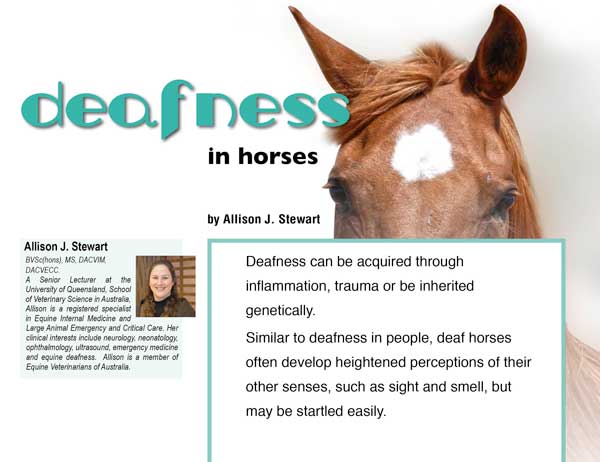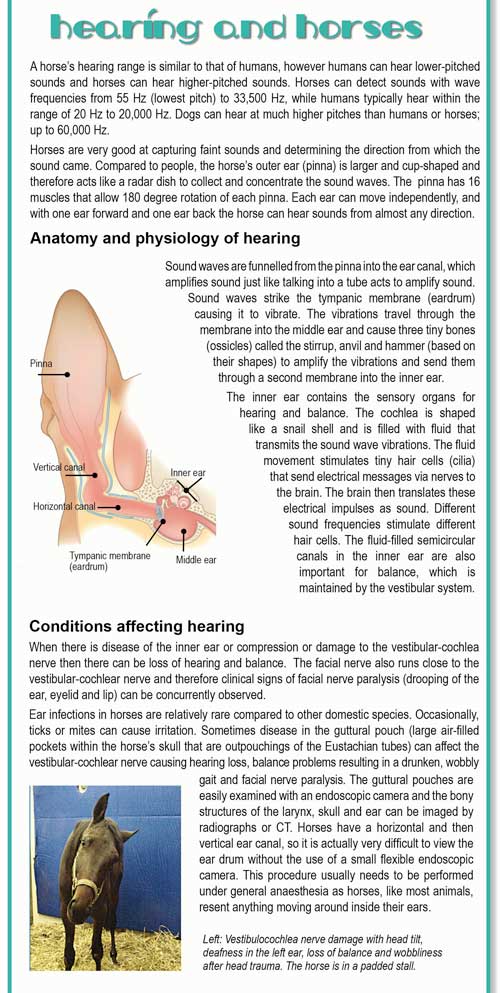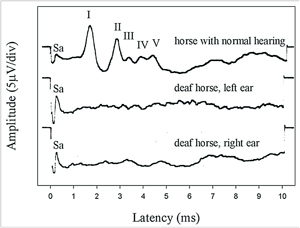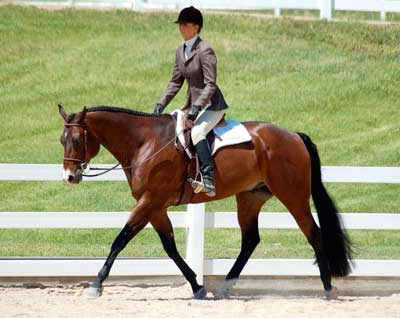
CAN YOUR HORSE HEAR YOU? Equine Deafness
Allison J. Stewart BVSc(hons), MS, DACVIM, DACVECC Equine Specialists Hospital, School of Veterinary Medicine, University of Queensland, Gatton Campus.
A Senior Lecturer at the University of Queensland, School of Veterinary Science in Australia, Allison is a registered specialist in Equine Internal Medicine and Large Animal Emergency and Critical Care. Her clinical interests include neurology, neonatology, ophthalmology, ultrasound, emergency medicine and equine deafness. Allison is a member of Equine Veterinarians of Australia.
Fight and Flight
Evolutionarily, horses were prey animals and therefore they have a very keen sense of hearing and response to noise. This can become frustrating for riders as small and seemingly insignificant noises can easily spook a horse. We have all seen a horse quietly grazing in the paddock and then suddenly lift its head, prick its ears and stare intently at the horizon. It has detected a distant sound, frequently inaudible to the human ear.
When trail riding, a horse may sense danger from the sound of a car backfiring and try to take-off at a gallop. Sometimes it’s the other way around, the startling sound can cause the rider to tense as a reaction and the horse, being well in-tune to its rider’s fears, can then react to the rider’s tension. There is a story of the horse, that when ridden by a deaf child, never spooked at any sounds because it was in fact the horse’s perception of the rider’s fear in response to a noise that was the main cause of the horse’s anxiety. Horses can certainly spook because of sights, touch and smell, in addition to sounds.
Deafness and hearing tests
Hearing aides have never been used on horses, and in fact deafness can be an asset and not a disability for a nervous horse! Noises at a show can spook some animals, and as long as the rider is aware of the horse’s inability to hear and is careful to use the senses of sight and touch, then in many respects deaf horses may have an advantage compared to those with a normal sense of hearing.
Similar to other species, it is likely that hearing ability declines with age although only limited research has been performed and routine diagnostic hearing testing does not occur.
Hearing tests are performed using a brainstem auditory evoked response, known as BAER testing. In this procedure headphones are held over the horse’s ears (or earbuds are inserted into the ear canals), and a series of click noises of various intensities are generated to stimulate the auditory pathway from the ear to the brain (left, BAER testing). Several tiny electrode wires are inserted just under the skin over the horse’s head and are used to monitor the brain’s response to the clicking sounds. Specialised equipment is required, but the BAER procedure takes about 15 minutes to perform and is tolerated well by most horses, often being able to be performed without sedation.
In a horse that hears normally, the waveform of the evoked potential consists of a series of five-to-seven characteristic waves, while in a deaf horse there is either complete absence of the waveform if the deafness is at the level of the inner ear, or a partial waveform if the deafness is due to a defect in other parts of the auditory pathway (see diagram below).
BAER testing is routinely performed on all newborn human babies to assess hearing ability.
The first published case of confirmed deafness in a horse was a 3-year-old overo Paint gelding with a bald-face; a completely blue right eye and partial blue left eye. The horse’s owners reported that they had never heard him whinny. He also seemed oblivious to typical horse-show noises. Congenital deafness is more common in blue eyed, bald-faced horses, though many can still hear normally. The investigating team (led by Dr Stewart in her previous position at Auburn University in the USA) used a BAER test to confirm deafness. The BAER test was also performed in a normal, control horse with a series of five-wave-peaks, while the BAER in the suspected deaf horse showed an absence of all peaks, thus confirming deafness, with the problem originating in the inner ear, rather than at some point further along the auditory pathway.
 |
|
 |
| |
|
Most riders would never notice mild hearing loss in their horse. |
| |
|
|
Hearing and the senior horse
Australian researchers compared hearing ability in two groups of horses, aged 5 to 8 years and 17 to 22 years, and found mild-to-moderate reduction in the ability to hear in the older group. The study was small and deafness rarely rates a mention in most equine veterinary textbooks. Horses do not live as long as people and tend not to go to rock concerts or work close to jack-hammers or noisy machines, therefore there is probably less of a toll of loud noise on the sensory receptors in the inner ear.
Overall, deafness is rare in horses. It can be ruled out by electronic testing using a BAER or simply by noting the horse’s reaction to a sudden noise, such as clapping your hands or banging on a metal bucket. An unexpected loud sound should prompt a startle reaction or at least a twitch of an ear. An absence of a startle reaction indicates complete deafness in both ears. It is impossible to diagnose deafness in a single ear without the use of a BAER.
Although not well documented, it appears that many horses that have been deaf from birth also do not whinney. This is similar to complete deafness in children who can therefore never learn to talk.
Congenital deafness occurs in some Paint horses with ‘splashed white’ or frame overo coat patterns. Some splashed white horses with a ‘bald’ white face or an extremely wide blaze, with blue eyes and variable white markings on the legs and body can be born deaf. Researchers have identified three separate genetic mutations that can produce the pattern in Paints and Quarter Horses, and one of the defects also occurs in Trakehners, Morgans and a few other breeds. Horses can be tested for the splashed white mutations by sending a hair sample to The University of California, Davis, (USA) for a genetic test. During development, the genes of these horses suppress pigment-producing cells called melanocytes, resulting in patches of pink skin with white hair and potentially blue eyes. If there is a lack of pigment extending into the inner ear it affects the sound-sensitive hair cells (cilia) and leads to deafness.
Pure white (or white with a small brown spot) foals that are born from two Overo Paint parents can be affected by a ‘lethal white’ gene. These foals are deaf, which would be a minor problem, however the genetic defect also affects the nervous system resulting in an inability to move food along the gastrointestinal tract, which ultimately results in severe bloat, signs of colic and failure to pass meconium or other faecal matter. The genetic defect is lethal and such foals should be humanely euthanised.
In horses with a white face and blue eyes, hearing should be tested as part of a pre-purchase examination. However, although deafness should be noted, it is not necessarily a reason not to purchase the horse. Deafness may be advantageous rather than a handicap, because the horse won’t ever spook because of noises. However, it may spook if something suddenly touches it or enters its field of vision without warning.
Similar to deafness in people, deaf horses often develop heightened perceptions of their other senses, such as sight and smell. Obviously the horse can not be trained to voice commands, but many deaf horses have had very successful show careers. ‘Colonels Smokingun,’ or ‘Gunner’ for short, was a famous United States reining champion. He had a bald face, blue eyes and had been deaf since birth, yet won $177,226 USD in a stellar career. As a popular breeding stallion he frequently passed on his classic white head, blue eyes and congenital deafness.
To investigate the cause of deafness in an individual, a detailed case history is important, as many factors can contribute to deafness. Hearing tests using a BAER can easily and safely be performed in horses at many university veterinary teaching hospitals. Blue eyed Paint horses that are deaf can be diagnosed from birth, with accurate BAEP recordings having been performed successfully in 2- to 4-day-old foals. Although deaf animals generally have normal mental capacities, owners should be aware that deaf horses are reliant on visual and vibratory sensory information, and are therefore more likely to be startled if special considerations of their deafness is not routinely performed. |